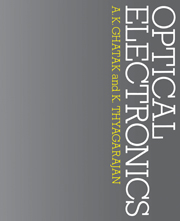Book contents
- Frontmatter
- Contents
- Preface
- 1 Maxwell's equations and propagation of electromagnetic waves
- 2 Reflection and refraction of electromagnetic waves
- 3 Wave propagation in anisotropic media
- 4 Fraunhofer diffraction
- 5 Fresnel diffraction
- 6 Spatial frequency filtering
- 7 Holography
- 8 Lasers: I
- 9 Lasers: II
- 10 Some laser systems
- 11 Electromagnetic analysis of the simplest optical waveguide
- 12 Leaky modes in optical waveguides
- 13 Optical fibre waveguides
- 14 Integrated optics
- 15 The electrooptic effect
- 16 The strain optic tensor
- 17 Acoustooptlc effect: Raman–Nath diffraction
- 18 Acoustooptic effect: Bragg diffraction
- 19 Acoustooptic devices
- 20 Nonlinear optics
- Appendices
- References and suggested reading
- Index
13 - Optical fibre waveguides
Published online by Cambridge University Press: 05 June 2012
- Frontmatter
- Contents
- Preface
- 1 Maxwell's equations and propagation of electromagnetic waves
- 2 Reflection and refraction of electromagnetic waves
- 3 Wave propagation in anisotropic media
- 4 Fraunhofer diffraction
- 5 Fresnel diffraction
- 6 Spatial frequency filtering
- 7 Holography
- 8 Lasers: I
- 9 Lasers: II
- 10 Some laser systems
- 11 Electromagnetic analysis of the simplest optical waveguide
- 12 Leaky modes in optical waveguides
- 13 Optical fibre waveguides
- 14 Integrated optics
- 15 The electrooptic effect
- 16 The strain optic tensor
- 17 Acoustooptlc effect: Raman–Nath diffraction
- 18 Acoustooptic effect: Bragg diffraction
- 19 Acoustooptic devices
- 20 Nonlinear optics
- Appendices
- References and suggested reading
- Index
Summary
Introduction
Since optical frequencies are extremely large (∼ 1015 Hz), as compared to conventional radio waves (∼ 106 Hz) and microwaves (∼ 1010 Hz), a light beam acting as a carrier wave is capable of carrying far more information in comparison to radio waves and microwaves. It is expected that in the not too distant future, the demand for flow of information traffic will be so high that only a light wave will be able to cope with it.
Soon after the discovery of the laser, some preliminary experiments on. the propagation of information-carrying light waves through the open atmosphere were carried out, but it was realized that because of the vagaries of the terrestrial atmosphere – e.g., rain, fog etc. – in order to have an efficient and dependable communication system, one would require a guiding medium in which the information-carrying light waves could be transmitted. This guiding medium, is the optical fibre which is hair thin and guides the light beam from one place to another (see Fig. 13.1). In addition to the capability of carrying a huge amount of information, fibres fabricated with recently developed technology are characterized by extremely low losses (∼ 0.2 dB/km) as a consequence of which the distance between two consecutive repeaters (used for revamping the attenuated signals) can be as large as 250 km.
- Type
- Chapter
- Information
- Optical Electronics , pp. 364 - 420Publisher: Cambridge University PressPrint publication year: 1989



